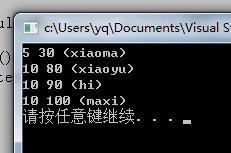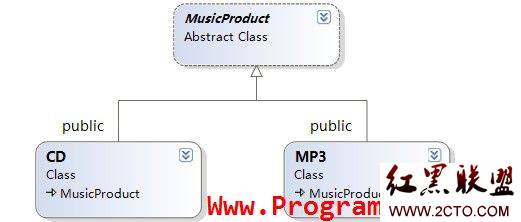串的堆式存储结构
在C和C++语言中 ,提供一个称之为“堆”的共享空间,可以在程序运行过程中,系统利用函数malloc( )和free( )动态地申请或释放一块连续空间。
由于在C和C++语言中可以用指针对数组进行访问和操作,在串的存储和操作上也可以充分利用上述特性。
串的堆式存储结构类似于线性表的顺序存储结构,以一组地址连续的存储单元存放串值字符序列,其存储空间是在程序执行过程中动态分配的,而不是静态分配的。
串的堆式存储结构定义
Typedef struct { char *ch; //指针域,指向存放串值的存储空间基址 int length; // 整型域:存放串长 }HString;
说明:在这种存储结构下,由于串仍然是以数组存储的字符序列表示,因此此类串的操作是先为新生成的串分配一个存储空间,然后进行“字符序列的复制”。例如,如串插入操作StrInsert(S,pos ,T)(将串T插入到串S的第pos字符之前)的算法是,为串S重新分配大小等于串S和串T长度之和的存储空间,然后进行将S和T串值复制到新分配存储空间中。
串的一系列实现 www.zzzyk.com
/*
串的堆式存储表示
*/
#include<stdio.h>
#include<stdlib.h>
#define OVERFLOW -2//堆溢出
#define OK 1//函数执行成功
#define ERROR -1//函数执行失败
typedef int datatype;
typedef struct{
char* ch;//指针域,指向存放串值的存储空间基址
int len;// 整型域:存放串长
}HString;
//初始化一个空串
datatype InitHString(HString* s)
{
s->ch=(char*)malloc(sizeof(char));
if(NULL==s->ch) return OVERFLOW;
s->ch=NULL;
s->len=0;
return OK;
}
//为串赋值
datatype assigment_string(HString* s, const char* str)
{
if(s->ch) free(s->ch);
int length=0,i;
while(str[length]!='\0')
length++;
s->ch=(char*)malloc(length*sizeof(char));
if(!s->ch) return OVERFLOW;
for(i=0;i<length;i++)
*(s->ch+i)=*(str+i);
s->len=length;
*(s->ch+s->len)='\0';
return OK;
}
//打印
void PrintString(const HString* s)
{
int i=0;
while(*(s->ch+i)!='\0')
{
printf("%c",*(s->ch+i));
i++;
}
printf("\n");
}
//求串的长度
datatype GetLength(const HString* s)
{
int len=0;
while(*(s->ch+len)!='\0')
len++;
return len;
}
//查找某个字符的位置,返回位序
datatype HSLocal(const HString* s,char c)
{
int i;
for(i=0;i<s->len;i++)
{
if(c==*(s->ch+i))
return i+1;
}
return -1;
}
//串的连接
datatype HSCat(HString* s,const HString* t)
{
int i=0;
char* temp=(char*)malloc((s->len+t->len)*sizeof(char));
if(!temp) return OVERFLOW;
for(i=0;i<s->len;i++)
*(temp+i)=*(s->ch+i);
free(s->ch);//释放防止内存泄漏
for(i=0;i<t->len;i++)
*(temp+i+s->len)=*(t->ch+i);
s->len+=t->len;
s->ch=temp;//使s->ch重新指向temp
*(s->ch+s->len)='\0';
return OK;
}
datatype HSCopy(HString* to, const HString* from)
{
//如果目标串不为空则清空
[cpp] view plaincopy
if(to->ch)
{
free(to->ch);
to->ch=NULL;
to->len=0;
}
int i=0;
to->len=from->len;
to->ch=(char*)malloc(from->len*sizeof(char));
if(!to->ch) return OVERFLOW;
for(i=0;i<from->len;i++)
*(to->ch+i)=*(from->ch+i);
*( to->ch+to->len)='\0';
return OK;
}
//在串s的pos位置处插入串t
datatype HSInsert(HString* s,const HString *t,int pos)
{
if(pos<0 || pos>s->len)
return ERROR;
else{
s->ch=(char*)realloc(s->ch,(s->len+t->len)*sizeof(char));
int i,j=1;
//后移
for(i=s->len+t->len-1;i>=pos+t->len;i--)
{
*(s->ch+i)=*(s->ch+(s->len-j));
j++;
}
//insert
for(i=0;i<t->len;i++)
*(s->ch+i+pos)=*(t->ch+i);
}
s->len+=t->len;
*(s->ch+s->len)='\0';
return OK;
}
//在串s的index位置删除长度为x个字符
datatype HSdel(HString* s,int index,int x)
{
// index value invalid
if(index<0 || index>s->len) return ERROR;
// if x+index> s->len
if((index+x)>=s->len)
s->len=index;
else
{
补充:软件开发 , C++ ,




